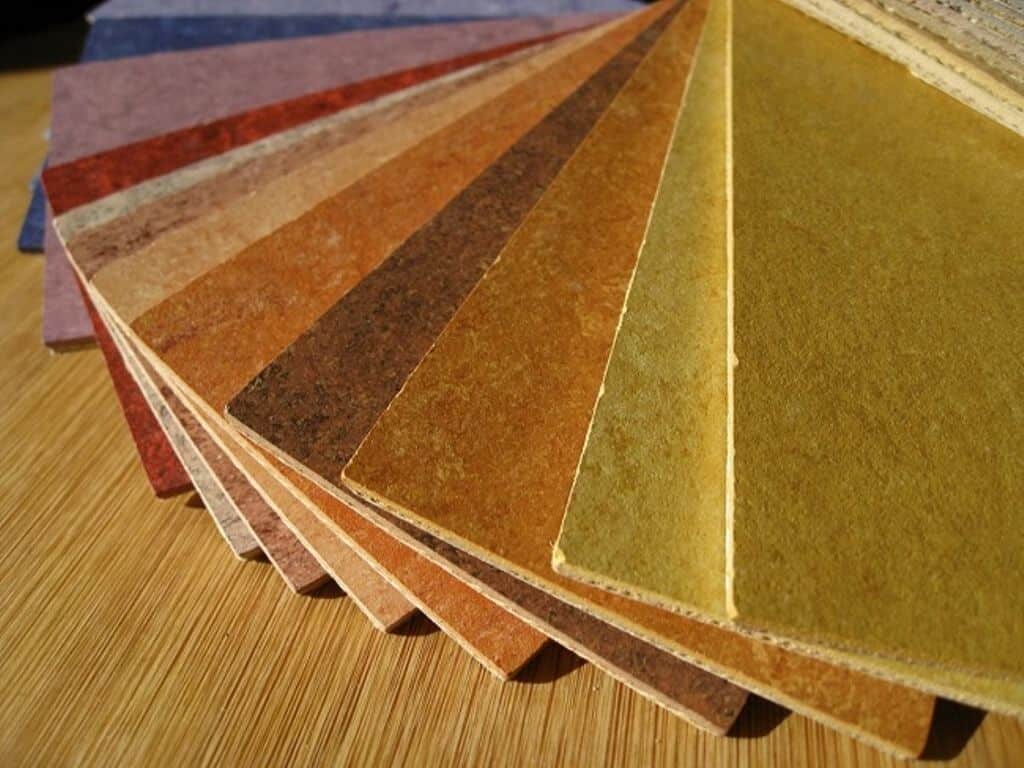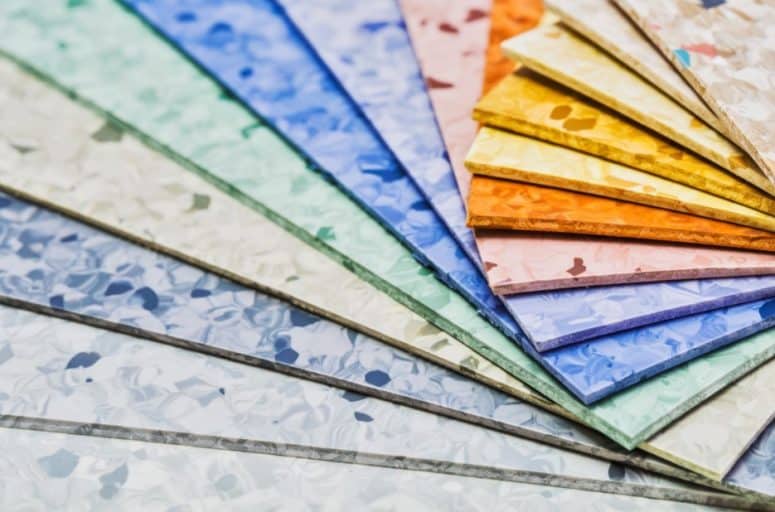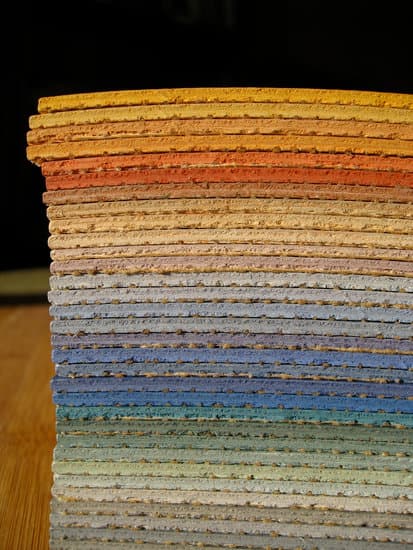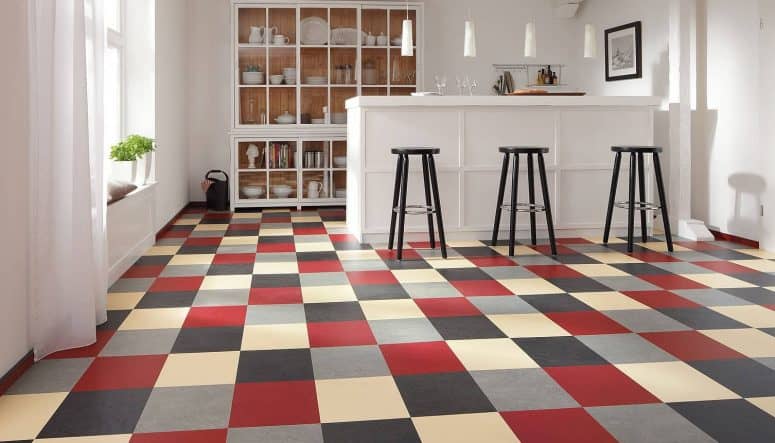What Is Linoleum Flooring?

Linoleum flooring is often misunderstood the same as vinyl flooring. Well, they both look alike in terms of looks. However, they are very much different in some significant aspects.
While vinyl flooring is constructed with synthetic materials like PVC as its main, linoleum flooring is so much more natural.
Linoleum flooring is made of linseed oil, tree resins (usually from pine tree), cork powder, and mineral pigments.
Those natural materials also create bouncy textures in linoleum flooring which makes it different from vinyl.
You are going to find all you need to know or consider, about linoleum flooring here, including its strength and weaknesses in every way possible.
Linoleum Floors Materials
We talked previously on linoleum’s material in general. Well, yes it is constructed with those natural resources mentioned earlier.
But, do you now in detail on which materials used where?
- Wear Layer: On the top of the layer is the coating for the linoleum flooring which usually comes together when you order it.
- Image Layer: The image layer of linoleum flooring is simultaneously embedded throughout the elements, not in a separate image layer. So, it is in the same layer as the core.
- Base Layer (Core): The core of the linoleum flooring is the compressed material through modern construction with the linseed oil, cork flour or dust, and those mineral pigments to make the embedded image on the top of the surface looks smooth.
Linoleum flooring is not necessarily separated layer by layer.
It is the compressed form of resilient flooring with natural and biodegradable materials, as well as the coating on top of some sold products to enhance its quality.
Linoleum Flooring Pros & Cons
To begin with, let’s talk about something matters the most when people want to know more about flooring options.
Yes, it is the pros and cons of linoleum flooring. Despite its positivity in all-natural resources as its material, linoleum flooring also has some considerable points fro you before taking it as your flooring material.
The Pros of Linoleum Flooring
- Eco-friendly
- Budget-friendly
- Durable
- Easy to maintain
- Gorgeous look
What’s best in eco-friendly materials is the future impact. Linoleum flooring is biodegradable and is not gonna harm in landfills.
Talking about the future, besides this is not gonna harm our environment, linoleum floors are not gonna harm your budget as well.
That is because linoleum flooring is very durable that you usually have the warranty up to 25 years for this.
Even better, you can reach the number of 40 years if you take really good care and proper maintenance.
Speaking of maintenance, linoleum flooring has easy maintenance. You just need to do regular sweeping for the dust and usual mopping to clean it more.
It looks like wood yet it doesn’t need much more maintenance like one, perfect, right?
Also for that, linoleum flooring’s look is very much well-maintained because it has that mineral pigments, not only on the top of its layer but also in all materials.
Linoleum flooring is very durable and it’s followed by well-maintained looks. Gorgeous!
The Cons of Linoleum Flooring
- Easy to leak
- Not suitable for wet areas
- Usually comes without coating
- Fades in sunlight
- Slippery if coated
Nevertheless, here are some considerable cons of linoleum. Linoleum flooring is sensitive to sharp elements like high heels, for instance. Sharps could cut or leak the surface of linoleum.
Also, linoleum flooring is not recommended to be installed in the bathroom or wet areas.
That’s because the surface and layers of linoleum flooring could be easily damaged by a certain amount of water. So you need to be careful in choosing where to install linoleum.
About the installation, usually, it comes without coating. Without the coating, the surface of linoleum flooring is very sensitive towards sunlight exposure.
The color could be darkened or faded by sunlight. That is why people usually order linoleum with coating.
But, the freshly coated linoleum flooring could be very slippery if you step on it.
Where should linoleum flooring be used?
Linoleum flooring is very versatile. It has the soft texture every room suits on.
It also has some kind of couchy texture on the surface, making you feel comfortable in stepping on it. That softness makes it less noisy than vinyl as well.
Besides, the fact that linoleum flooring comes in various designs, colors, and textures, also make it an option for many.
You can install linoleum in your bedroom, working space, or house corridors. Linoleum flooring suits those rooms with light to heavy traffic.
One of the characteristics of linoleum flooring is that it is waterproof, but could not withstand so much water like in watery areas.
Therefore, you can install it in your kitchen as well. There are many recommendations about installing linoleum in the kitchen, though.
The Cost of Linoleum Flooring
Linoleum flooring looks just like vinyl, but it has different materials. What about the price?
Well, linoleum flooring costs not far from vinyl’s cost. Linoleum flooring comes in three different forms, which are planks, tiles, and sheets.
Both come in a different range of prices as well.
Plank linoleum ranges from $4 to $6 per square foot. Meanwhile, it ranges from $2.50 to $3.50 per square foot for sheets and tiles.
The range is not very far, but planks come more pricey. For planks and tiles, you can install them yourself.
However, for the sheets, you should call the professionals to do the installation because it is quite tricky. It could curl or wrinkle your linoleum sheets on the floor without correct methods.
For the clean installation, it costs extra, which ranges around $700 up to more than $2000.
That would be based on how difficult the installation is, and how wide the room is.
Do I need Subfloor / Underlayment?
Basically, neither do you need a subfloor nor an underlayment for the installation of linoleum flooring.
For plank linoleum especially, there is this snap-together feature on the edge of linoleum plank flooring for you to install it yourself without having to glue or nail it.
However, you are going to get a lot of struggle in installing the sheets one. That is where sometimes people use a subfloor or underlayment.
A subfloor is used preferably if you would like to have a more balanced and leveled base for your flooring. That works just fine with an underlayment too.
You just need to level your underlayment and give 1 to 3 inches of space between the subfloor and the linoleum floor, to make it expand naturally later after the installation.
That would make the installation works properly and the floor is gonna be sturdy.
How Durable Are Linoleum Floors?
Linoleum flooring is usually backed 25 years warranty by the manufactures. But this could be up to 40 years’ lifespan with proper care and maintenance.
That number is two times more than vinyl flooring that looks similar to linoleum, as they are both resilient type of flooring.
Nevertheless, linoleum flooring still needs special attention in some aspects to get that long lifespan.
There is this process called ambering, which means the process of the floor turns into more yellowish due to sunlight exposure.
Therefore, you need to have a protective coating that you can order from the manufacture or the place you order the flooring from.
Above all that, be careful of sharp elements and too much water spill. Sharp elements such as high heels in such high traffic could harm the floor because linoleum could not withstand sharp elements.
Water spill, on the other hand, also needs to be controlled. Yes, linoleum flooring is waterproof, but it could not withstand too much water on its surface.
Otherwise, this would make the layers worn out fast. That would shorten the lifespan, for sure.
Linoleum Flooring Maintenance
Good news for this one! Linoleum flooring is one of the easiest flooring options to clean and maintain. The note for you is that you need to regularly clean it with mild and non-ammonia-based flooring cleansers.
That works to protect the protective coating from too heavy detergent which could harm the material as well. Another thing is easy. You need to sweep the floor or vacuum it lightly to remove dust and dirt.
In addition, you need to give a damp mopping with warm water to the linoleum floor. It is suggested to use a rag and mild detergent because those are enough to handle stains.
Last but not least, the ambering process is one thing that worries many customers.
To avoid the ambering to happen due to sunlight exposure, you should wax the floor every two or three years.
You don’t want your authentic eco-friendly linoleum flooring gets yellowish, do you? Besides, waxing could also protect the floor from scratch and overly water spill.


